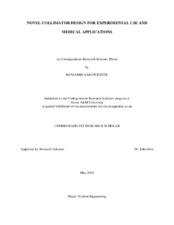| dc.creator | Sarawichitr, Benjamin | |
| dc.date.accessioned | 2019-06-10T16:16:02Z | |
| dc.date.available | 2019-06-10T16:16:02Z | |
| dc.date.created | 2020-05 | |
| dc.date.submitted | May 2020 | |
| dc.identifier.uri | https://hdl.handle.net/1969.1/175431 | |
| dc.description.abstract | Intensity modulated radiation therapy (IMRT) is a type of radiation therapy that tries to minimize the radiation dose to healthy tissue through the use of various types of collimators that shapes the radiation beam to the shape of the tumor (Ezzell et al.). A series block and wedge collimators are used to square off the beam before a multi-leaf collimator (MLC) shapes the beam to the shape of the tumor. While the MLC can shape the beam to the shape of the tumor, the shaped beam is not to the exact shape of the tumor. This is due to the leaves of the collimator being rectangular creating a stairstep pattern beam shape causing some healthy tissue to receive radiation (Boyer et al.). A variable aperture collimator attempts to solve this issue by having circular contour that matches the smooth contours that tumors have. However, the variable aperture collimator is restricted to solely circles of various sizes to shape the beam (van de Water et al.). Even though this solves the problem of the stairstep pattern of the multi-leaf collimator, it presents its own problem since tumors are not perfect circles, so there will still be mismatch between the prescribed treatment field and the beam shape. A collimator that has the shape variability of the multi-leaf collimator and the smooth contours of the iris collimator might be able to further reduce the amount of radiation dose healthy tissues receive while maximizing the amount of dose that the tumor receives.
A design that combines a multi-leaf and a variable aperture collimator was developed in order to achieve the goal of maximizing radiation dosage to the tumor and minimizing the dosage to the surrounding healthy tissue. The effects of how the shape of this new design attenuates and shapes a radiation beam was studied by simulating a beam in Monte Carlo N-Particle Transport Code (MCNP) and by creating the design and testing with a radiation beam and using radiochromic film to observe the dose distribution and edge effects. | en |
| dc.format.mimetype | application/pdf | |
| dc.subject | Collimator | en |
| dc.subject | Radiation Therapy | en |
| dc.subject | Medical Physics | en |
| dc.subject | Intensity Modulated Radiation Therapy, CyberKnife | en |
| dc.title | Novel Collimator Design for Experimental Use and Medical Applications | en |
| dc.type | Thesis | en |
| thesis.degree.department | Nuclear Engineering | en |
| thesis.degree.discipline | Nuclear Engineering | en |
| thesis.degree.grantor | Undergraduate Research Scholars Program | en |
| thesis.degree.name | BS | en |
| thesis.degree.level | Undergraduate | en |
| dc.contributor.committeeMember | Ford, John | |
| dc.type.material | text | en |
| dc.date.updated | 2019-06-10T16:16:02Z | |


